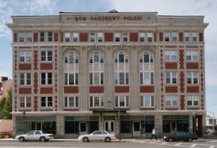How can "rehab codes" facilitate rehabilitation of older homes?Rehab
codes are special building codes designed to make it easier to renovate
older homes, while ensuring that modern safety concerns are addressed.
Traditional
building codes
often require that older buildings be brought into full compliance with
current standards for new construction, even when a project calls for
only moderate levels of
rehabilitation.
The additional renovations necessitated by these requirements -- such
as the widening of staircases or raising of ceilings -- can
significantly increase the cost of a proposed project without
contributing substantially to greater safety, creating a disincentive
to restore or modernize existing structures.
Learn more about obstacles to renovation posed by traditional building codes.
To
remedy this problem, a growing number of states and localities have
adopted rehab codes that tailor compliance requirements to the type and
extent of work planned. Created specifically to address redevelopment
in older buildings, rehab codes keep regulation predictable and
proportionate to the scope of the project, while still ensuring
resident safety. With new home construction slowing, effective rehab codes will take on increasing importance. The renovation of attractive, but dilapidated older
buildings can be an excellent vehicle for stabilizing neighborhoods, providing mixed-income housing and sparking downtown revitalization.
What problems do "rehab codes" solve?
Rehab
codes reduce the financial obstacles to rehabilitation posed by
unrealistic requirements in building codes intended for new
construction. Rehab codes also help to alleviate unpredictability in
the development process by specifying which requirements are triggered
by different types of redevelopment projects.
Without this
sensitivity to the differences between new construction and the rehab
of existing structures, buildings in need of moderate restoration can
fall further into disrepair. Many foreclosed homes are in need of rehabilitation because home repairs are often the first expense to be cut when homeowners encounter financial difficulties. In a weak housing market, these buildings
can stay vacant for years, reducing the potential tax base, potentially
increasing crime, and impeding neighborhood stabilization and community revitalization. In a stronger
housing market, buildings that are allowed to completely deteriorate
may eventually be
| Solutions in Action
|

Photo courtesy of MB Properties
Dom Narodowy Polski Apartments
in Chicopee, Massachusetts provide 50 units of affordable senior
housing. Built in 1930 and renovated in 1982, the property is currently
undergoing further renovations, including replacement of boilers with
energy efficient models and a partial roof replacement. Visit the Gallery to learn more about Dom Narodowy Polski Apartments. |
torn down and replaced with newer, more expensive
homes that are out of
reach of working families.
Finally,
building codes that make renovation more feasible help to maintain the
character of older homes and historic neighborhoods by facilitating the
preservation of aging structures. From an environmental perspective, the rehabilitation of existing buildings is an inherently "green" option since it utilizes existing structures and materials that might otherwise be demolished.
Click here to learn more about the environmental benefits of preserving existing housing stock.
Where are these policies most applicable?Not
surprisingly, rehab codes are most applicable in communities with a
significant supply of older housing stock, particularly in places with
large numbers of
vacant, foreclosed, or
abandoned properties
in need of repair. When rehabilitation is too difficult or costly, it
can be difficult to bring these structures back into productive use.
Municipalities concerned about stimulating downtown revitalization and reducing the extent of
sprawl
on the urban fringe also may wish to consider the adoption of rehab
codes; without these more flexible standards, developers may choose to
focus on easier-to-build new construction on the edges of the community
rather than potentially costly
infill redevelopment projects.
Click here to learn more about infill development
 Learn more about rehab codes Learn more about rehab codes
 Go
back to learn about other policies that help Reduce Red Tape. Go
back to learn about other policies that help Reduce Red Tape. |

 Learn more about rehab codes
Learn more about rehab codes